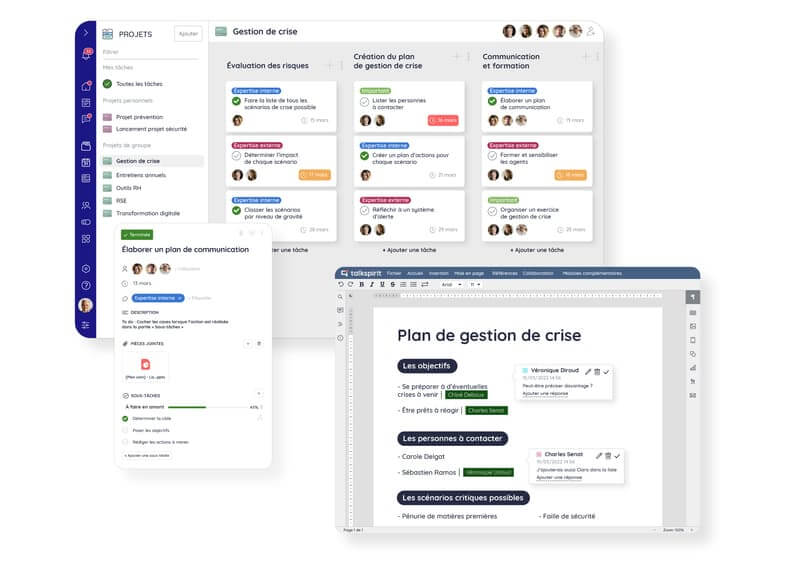Managing a project is a big responsibility. There are a lot of moving parts, from how to assign tasks to how to manage communication to how to ensure deliverables are being completed on time.
And if you don’t manage all of those moving parts effectively, it could lead to setbacks, missed deadlines, or—worst case scenario—not finishing the project at all.
Luckily, all it takes to effectively manage your projects is the right strategy. So what, exactly, does that strategy look like?
Let’s take a look at four key steps you’ll want to take in order to manage your project in the most effective, productive way possible:
Define the entire scope of the project
Before you can move forward with effectively managing a project, you need to know what, exactly, you’re managing.
Or, in other words, you need to define the scope of the project.
Before you get too far into the project planning or management phase, take time to define the key elements of the project, including:
- Project objectives. What are you trying to accomplish with this project?
- Project deliverables. What do you need to create or deliver in order to successfully complete the project?
- Timeline. How long do you have to complete the project?
- Budget. What kind of financial resources do you have to spend on the project?
- Labor needs. What kind of labor do you need to complete the project—and what kind of resources do you have within your organization to fill those needs? (For example, if your project is heavy on design work, you would need a team of designers to successfully complete the project.)
- Tools. What tools are available to help you plan, manage, and complete your project? Are there any gaps—and, if so, what kind of tools do you need to fill those gaps and take the project to the finish line?
Defining the scope of your project will give you a big-picture view of all the different elements you’ll need to successfully complete it. You’ll be able to look at the project as a whole—and once you do that, the next step of the process?
Break it down into smaller, more manageable parts…
Understanding the project as a whole is important. But if you want to successfully manage your project to completion, you need an actionable plan to get from where you are (project concept) to where you want to go (project completion).
And that way to do that? Break down your larger project objective into smaller, more manageable goals.
This will help you hit your larger objective in a few different ways, including:
- Makes the project feel less overwhelming. Thinking about a project in its entirety—particularly if it’s a large, involved project—can feel overwhelming. Breaking down a major project into smaller parts can make the process feel more manageable and less overwhelming.
- Creates an actionable plan. In order to successfully complete a project, you need an actionable plan. Breaking down a project into smaller parts—and breaking down those smaller parts into actionable tasks—is a key part of taking a larger project objective and transforming it into an actionable plan that drives results.
- Creates milestones to monitor progress. Breaking down a project into smaller parts also allows you to better monitor the project’s progress. Rather than waiting until the end of the project to assess progress and efficiency, breaking the project down into smaller parts gives you multiple opportunities to check in as the project progresses, make sure you’re on track to hit your project goals, and adjust your strategy as necessary.
If you’re gearing up for managing a project, take the overall project and break it down into smaller, more manageable objectives.
…and then break those smaller parts into actionable tasks
Then, break it down even further into actionable tasks you can assign to your team.
For example, let’s say your project objective is to create a new pitch deck for your company.
You might break down that overarching goal into smaller objectives, like “research sales data,” “create graphics,” or “gather customer stories.” Then, from there, you would break down each objective into a task list to assign to your team (for example, you might break down “gather customer stories” into tasks like “schedule case study interview with customer A,” “write testimonial for customer B,” or “proofread customer story for customer C”).
Assign tasks accordingly
Once you’ve broken down your project into a list of clear, actionable tasks, the next step to effectively managing a project is assigning those tasks.
When you assign tasks, it’s important to consider a few things, including:
- How much time you’re giving employees/teams to complete the task. Part of effectively managing a project is sticking to the project’s timeline. And in order to do that, you need to set realistic deadlines. There’s no one-size-fits-all approach to deadlines, but try to set deadlines that keep your team engaged, but are also achievable. (If you set unrealistic deadlines, it could demotivate your team, making it harder to get things done.) Also, whenever possible, give yourself a bit of breathing room with deadlines. that way, if something goes wrong, you have time to fix it without holding up the entire project.
- How each task plays into the project as a whole. When you’re assigning tasks, it’s also important to think about how each task fits into the project as a whole—and assign tasks and deadlines accordingly. For example, let’s say you’re managing the design of a new marketing brochure. You can’t assign proofreading tasks until all of the copywriting tasks have been completed—so you’d want to schedule all the copywriting deadlines before you assign tasks to the proofreading teams.
- How you assign the tasks. How you assign project-related tasks can play a key role in how effectively you’re able to manage a project. And the best way to assign tasks? Using a project management tool. This allows you to not only assign tasks to employees, but share key information and files for that task, check in on progress, and organize project-related conversations. It also allows you to view each task within the context of the larger project—which can keep you on track for meeting your deadline.
Talkspirit is an all-in-one collaborative platform that offers a host of features that make it easier to manage and collaborate with your team—including project management. Talkspirit’s project management platform allows you to organize your projects, assign and prioritize tasks, and monitor project progress. In addition, the tool allows you to chat with your team, plan and hold physical and remote meetings, store your documents in a secure drive and co-edit documents in real time. With Talkspirit, you have everything you need for effectively managing a project from beginning to end!

Want to experience how Talkspirit can make project management easier and more effective for you and your team? Schedule a demo or sign up for a free trial today!
Schedule regular meetings to discuss progress and pivot as necessary
Your project is up and running. Tasks are assigned, employees are working, and you’re moving towards your project goals and objectives.
But managing a project doesn’t stop there! If you want to effectively see your project through to the finish line, you need to continually be monitoring your progress—and pivoting as necessary.
When you’re managing a project, it’s important to schedule regular meetings with key stakeholders to discuss where you are, how you’re progressing, and if anything needs to change in order to reach your goals. This may include rethinking deadlines or reassigning tasks to different teams or departments.
Also read: 10 tips and tricks for improving the efficiency of your remote meetings
For example, let’s say you originally set a deadline for the project to be completed in 30 days—but after meeting with the team at the 15-day mark, you realize you’re nowhere near halfway done with the project. In that scenario, you would want to get to the bottom of why you’re not progressing as planned—and then adjust your strategy to better hit your goals and keep the project moving forward.
In certain scenarios, you might even consider changing the direction of the project.
For example, let’s say the project you’re managing is a new product launch. But early in the project, your market research team completes their initial research and finds that the product concept is falling flat with your target audience. In that situation, you wouldn’t just keep moving the project forward as planned. Instead, you’d want to go back and brainstorm new product ideas.
The point is, if you want to effectively manage your project, you need to continually monitor how your project is progressing and moving forward. And if it’s not progressing or moving forward, you need to figure out why—and adjust your strategy accordingly.
Use these tips to effectively manage your next project
If you want to take your projects from the beginning stages to a successful completion, you need to know how to manage the process. And with these tips, you’re armed with the information you need to manage your next project in the most effective way—and reap the benefits that go along with that kind of effective management.
Looking for more tools to better manage your projects? Be sure to check out our round-up of 2022’s best project management software!
–
Author: Deanna deBara



![[Expert Opinion] Steps for Achieving a Successful HR Transformation](https://blog.talkspirit.com/wp-content/uploads/2024/02/Achieving-HR-transformation-400x250.jpg)